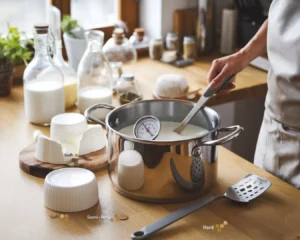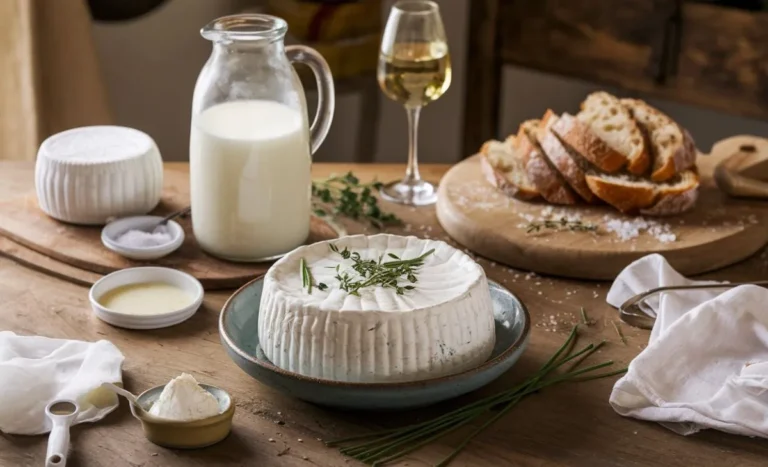How Can You Make Cheese from Scratch: Simple Recipes for Cheese Lovers
Introduction: The Joy of Making Cheese at Home
Making cheese at home is a rewarding and enjoyable experience that many food lovers cherish. If you’re wondering how can you make cheese from scratch, you’ll find that the process is both accessible and fulfilling. From the delightful aroma of warming milk to the satisfaction of crafting your own cheese, each step offers a unique journey. Whether you’re a beginner or an experienced cook, home cheese-making invites creativity into your kitchen.
One of the greatest joys of making cheese is the ability to customize flavors and textures. You can experiment with different types of milk, herbs, and spices to create unique cheeses that suit your palate. For instance, fresh herbs can add a burst of flavor to your homemade ricotta, while spices can transform mozzarella into a delightful gourmet treat. This creative freedom allows you to produce cheeses that reflect your personal taste and style.
Moreover, the sense of accomplishment that comes from crafting cheese is unmatched. Watching your milk transform into curds and whey is a magical process. As you gain experience, you’ll appreciate the nuances of aging and flavor development. Each successful batch will inspire you to explore new recipes and techniques, expanding your cheese-making skills.
Finally, making cheese at home fosters a deeper connection to your food. Understanding the ingredients and techniques behind cheese-making enhances your appreciation for this age-old craft. By learning how can you make cheese, you not only create delicious results but also join a community of passionate cheese lovers. Embrace this culinary adventure and enjoy the fruits of your labor, one delicious bite at a time.
Essential Ingredients: What You Need to Get Started
When exploring how can you make cheese from scratch, having the right ingredients is essential for success. The foundation of any cheese recipe is high-quality milk. Depending on the type of cheese you want to make, you can choose cow’s, goat’s, or sheep’s milk. Each variety brings its own unique flavor and texture, allowing you to experiment and discover your favorites. Always opt for fresh, unpasteurized milk if possible, as it yields the best results.
In addition to milk, you’ll need a coagulant to help curdle the milk. Rennet is the most common choice, but you can also use acid, such as lemon juice or vinegar, for certain cheeses. Rennet is available in both animal and vegetable forms, so you can select what suits your dietary preferences. This step is crucial, as it transforms the milk into curds, setting the stage for your cheese-making journey.
Next, bacteria cultures play a significant role in developing flavor and texture. Depending on the cheese you’re making, different cultures can be used to enhance taste and aroma. For instance, mesophilic cultures are perfect for softer cheeses, while thermophilic cultures work well for harder varieties. By understanding which cultures to use, you can create unique flavor profiles that elevate your homemade cheese.
Lastly, don’t forget about salt, which is an important ingredient in cheese-making. Salt not only enhances flavor but also acts as a preservative, helping to control moisture and prevent spoilage. It’s best to add salt during the curd formation process and when aging your cheese. By gathering these essential ingredients, you’ll be well-equipped to answer the question of how can you make cheese, paving the way for delicious creations in your kitchen.
Tools of the Trade: Must-Have Equipment for Cheese-Making
To successfully answer the question of how can you make cheese from scratch, having the right tools is essential. The equipment you use can significantly impact the quality of your cheese. While some tools may seem specialized, many are simple kitchen items that you likely already own. Understanding what you need will set you up for cheese-making success.
First and foremost, a high-quality stainless steel pot is crucial. This pot should be large enough to hold the amount of milk you’ll be using. Stainless steel distributes heat evenly, which is important for controlling the temperature during the curdling process. Additionally, investing in a good thermometer is vital for monitoring the milk’s temperature accurately. This ensures that you achieve the correct curdling conditions, leading to better results.
Next, you’ll need cheese molds to shape your curds. These molds come in various sizes and shapes, allowing you to create everything from small rounds to larger blocks. Look for molds with drainage holes, as they help expel excess whey during pressing. A cheese press is also recommended for applying even pressure to the curds. This step is essential for achieving the desired texture in your final product.
Finally, don’t forget about cheesecloth and a slotted spoon. Cheesecloth is perfect for draining curds and separating them from the whey. A slotted spoon allows you to lift curds gently without breaking them apart. By equipping yourself with these essential tools, you’ll be well-prepared to tackle the exciting journey of how can you make cheese, transforming simple ingredients into delicious creations.

Step-by-Step Guide: Making Fresh Ricotta Cheese
If you’re wondering how can you make cheese from scratch, making fresh ricotta is a fantastic starting point. This creamy cheese is simple to prepare and requires minimal ingredients. With just milk, an acid, and a pinch of salt, you can create delicious homemade ricotta. Follow this step-by-step guide to enjoy the satisfaction of crafting your own cheese.
Begin by gathering your ingredients. You’ll need four cups of whole milk, one tablespoon of white vinegar or lemon juice, and half a teaspoon of salt. Using high-quality, fresh milk is essential for achieving the best flavor and texture. Pour the milk into a large stainless steel pot and heat it over medium heat. Stir occasionally to prevent the milk from scorching at the bottom.
Once the milk reaches about 190°F (88°C), remove it from the heat. Next, add the vinegar or lemon juice, stirring gently for about 30 seconds. You’ll notice the milk starting to curdle, separating into curds and whey. Allow the mixture to sit for about five to ten minutes. This resting period helps the curds form more completely, enhancing the final texture of your ricotta.
After the resting period, line a colander with cheesecloth and place it over a bowl to catch the whey. Gently pour the curds into the colander, allowing the whey to drain for about five minutes. Once drained, transfer the ricotta to a bowl and stir in the salt to taste. Enjoy your homemade ricotta fresh, or use it in various recipes. By following these simple steps, you can confidently answer the question of how can you make cheese and delight in the delicious results.
Crafting Creamy Goat Cheese: A Simple Recipe
If you’re eager to learn how can you make cheese from scratch, crafting creamy goat cheese is a delightful project. This versatile cheese offers a tangy flavor and a smooth texture, making it perfect for spreads, salads, or simply enjoying on crackers. With just a few ingredients and some straightforward steps, you can create your own delicious goat cheese at home.
To begin, gather your ingredients. You’ll need one quart of fresh goat’s milk, one tablespoon of lemon juice, and a pinch of salt. Using high-quality, fresh goat’s milk is key to achieving the best flavor. Pour the goat’s milk into a stainless steel pot and heat it over medium heat. Stir the milk gently to prevent it from scorching, and monitor the temperature closely.
Once the milk reaches about 190°F (88°C), remove it from the heat. Next, add the lemon juice, stirring gently for about 30 seconds. You will notice the milk curdling, with curds forming and separating from the whey. Allow the mixture to sit for about ten minutes. This resting period is crucial, as it helps the curds develop their characteristic texture.
After the resting time, line a colander with cheesecloth and place it over a bowl to catch the whey. Carefully pour the curds into the colander, allowing the whey to drain for about fifteen minutes. Once drained, transfer the curds to a mixing bowl and add a pinch of salt to taste. Mix gently until smooth, and your creamy goat cheese is ready to enjoy. By following these simple steps, you’ll confidently answer the question of how can you make cheese, savoring the fresh, homemade flavor of your goat cheese.
Exploring Classic Mozzarella: Techniques and Tips
If you’re curious about how can you make cheese at home, mozzarella is a classic cheese that’s both fun and rewarding to create. Known for its stretchy texture and mild flavor, mozzarella is a versatile addition to many dishes, from pizzas to salads. With the right techniques and a few tips, you can craft this delicious cheese from scratch and enjoy its fresh, homemade taste.
To start, you’ll need one gallon of whole milk, a rennet tablet, citric acid, and salt. Begin by dissolving 1 ½ teaspoons of citric acid in one cup of water and adding it to the milk in a large pot. Heat the milk to 90°F (32°C) while stirring gently to ensure even heating. Next, dissolve a quarter of a rennet tablet in water and stir it into the milk, allowing it to rest for 5-10 minutes to form curds.
Once the curds have formed, cut them into small cubes using a long knife. Heat the curds slowly to 105°F (40°C), stirring gently to prevent sticking. After reaching the desired temperature, remove the curds from the whey and place them in a microwave-safe bowl. Microwave the curds for about one minute, then knead and stretch them, continuing to heat if necessary until they become smooth and elastic.
Finally, season the mozzarella with salt and shape it into a ball or small rounds. Cool the cheese in ice water for a few minutes to firm it up. Enjoy your homemade mozzarella fresh or store it for later use. By following these techniques and tips, you’ll master the art of how can you make cheese from scratch, creating mozzarella that enhances any dish with its creamy, stretchy texture.
Aging and Enjoying: How to Store Your Homemade Cheese
When learning how can you make cheese from scratch, understanding how to properly age and store your creations is essential. Aging cheese not only enhances its flavor but also contributes to its texture. Each type of cheese requires different aging conditions, so knowing the best practices will ensure that your homemade cheese matures beautifully.
To begin with, the aging environment plays a crucial role in the process. Ideally, cheese should be stored in a cool, humid place, with a temperature between 50°F and 55°F (10°C and 13°C). A dedicated cheese cave or a wine refrigerator can work well for this purpose. If you don’t have those, a temperature-controlled basement can be a suitable alternative. Additionally, maintaining humidity levels around 80% is important to prevent the cheese from drying out.
Once you’ve created the perfect aging environment, it’s time to wrap your cheese properly. Use cheese paper, wax paper, or even a breathable cheese bag to allow airflow while protecting it from unwanted bacteria. Avoid using plastic wrap, as it traps moisture and can create a rubbery texture. Regularly check your cheese for signs of mold, and if you notice any, simply scrape it off to keep your cheese safe.
Finally, enjoy your cheese at its peak flavor. After aging, cut a small piece to taste, and explore the different flavors that develop over time. Homemade cheese can be enjoyed in various ways, such as on a charcuterie board, in salads, or melted over pasta. By mastering the aging and storage techniques, you’ll confidently answer the question of how can you make cheese, savoring the delicious results of your efforts.
How Can You Make Cheese: Exploring Different Methods and Techniques







